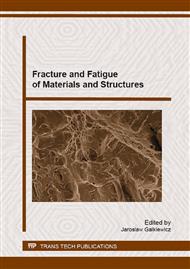[1]
Tomaszewski T., Sempruch J., Verification of the fatigue test method applied with the use of mini specimen, Key Engineering Materials. 598 (2014), 243-248.
DOI: 10.4028/www.scientific.net/kem.598.243
Google Scholar
[2]
Szala G., Ligaj B., Effect of the exponent in the description of Wohler fatigue diagram on the results of calculations of fatigue life, Fracture And Fatigue Of Materials And Structures, Key Engineering Materials Vol. 598 (2014), 231-236.
DOI: 10.4028/www.scientific.net/kem.598.231
Google Scholar
[3]
Ligaj B., Szala G., Comparative analysis of fatigue life calculation methods of C45 steel in conditions of variable amplitude loads in the low- and high-cycle fatigue ranges, Polish Maritime Research, 19/4 (2012) 23-30.
DOI: 10.2478/v10012-012-0037-z
Google Scholar
[4]
Pejkowski L., Skibicki D., Sempruch J., High-Cycle Fatigue Behavior of Austenitic Steel and Pure Copper under Uniaxial, Proportional and Non-Proportional Loading, Strojniski Vestnik-Journal Of Mechanical Engineering, Volume: 60/9, (2013), 549-560.
DOI: 10.5545/sv-jme.2013.1600
Google Scholar
[5]
Lipski A., Mrozinski S.: Approximate determination of a strain-controlled fatigue life curve for aluminum alloy sheets for aircraft structures. International Journal of Fatigue, (2012), 39, 2-7.
DOI: 10.1016/j.ijfatigue.2011.08.007
Google Scholar
[6]
Slezak T., Sniezek L., Fatigue Properties and Cracking of High Strength Steel S1100QL Welded Joints, Key Engineering Materials Vol. 598 (2014), 237-242.
DOI: 10.4028/www.scientific.net/kem.598.237
Google Scholar
[7]
Boronski D., Soltysiak R., Giesko T., Marciniak T., Lutowski Z., Bujnowski S., The Investigations of Fatigue Cracking of Laser Welded Joint With The Use of FatigueVIEW, System, Key Engineering Materials Vol. 598 (2014), 26-31.
DOI: 10.4028/www.scientific.net/kem.598.26
Google Scholar
[8]
Nasilowska B., Slezak T., Sniezek L., Torzewski J., Mechanical Properties of Laser-Welded Joints in the Difficult-to-Weld steels, Proceedings of 8th International Conference ITELMS '2013, May 23-24, Panevėžys, Lithuania, 173-178 .
Google Scholar
[9]
Gagnepain J. Ch., Duplex stainless steels: success story and growth perspectives, Stainless steel world 12 (2008), 31-36.
Google Scholar
[10]
Soulignac P., Gagnepain J. -C., Why duplex usage will continue to grow, Duplex Conference, Grado, Italy, 18–20 June, (2007).
Google Scholar
[11]
Practical Guidelines for the Fabrication of Duplex Stainless Steels, Third edition, Published by the International Molybdenum Association, London 2014, ISBN 978-1-907470-09-7.
Google Scholar
[12]
Liljas M., 80 years with duplex steels - a historic review and prospects for the future, ACOM 4 - 2010 OUTOKUMPU, 28-34.
Google Scholar
[13]
Iris Alvarez-Armas, Suzanne Degallaix-Moreuil Duplex Stainless Steels, ISTE Ltd (UK) and John Wiley & Sons (USA), (2009).
DOI: 10.1002/9781118557990
Google Scholar
[14]
French patent No 803361, (1936).
Google Scholar
[15]
Swedish patent No 312240, (1965).
Google Scholar
[16]
US patent No 3567434, (1971).
Google Scholar
[17]
German patent No 2255673, (1974).
Google Scholar
[18]
Liljas M, Canderyd C., Pettersson R., Willför M., Superaustenitic stainless steels in demanding environments, ACOM 4 - 2010 OUTOKUMPU, 28-34.
Google Scholar
[19]
Zhu X. -K., Joyce J., A., Review of fracture toughness (G, K, J, CTOD, CTOA) testing and standardization, Engineering Fracture Mechanics 85 (2012) 1–46.
DOI: 10.1016/j.engfracmech.2012.02.001
Google Scholar
[20]
Sieurin H., Sandstrӧm R., Fracture toughness of a welded duplex stainless steel, Engineering Fracture Mechanics 73 (2006) 377–390.
DOI: 10.1016/j.engfracmech.2005.03.009
Google Scholar
[21]
Soltysiak R., Effect of laser welding parameters of DUPLEX 2205 steel welds on fatigue life. Solid State Phenomena Vol. 223 (2015), 11-18.
DOI: 10.4028/www.scientific.net/ssp.223.11
Google Scholar
[22]
E399−12 Standard Test Method for Linear-Elastic Plane-Strain Fracture Toughness KIC of Metallic Materials.
DOI: 10.1520/e0399-08
Google Scholar


